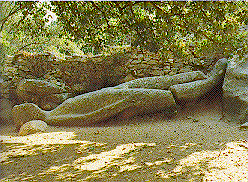 -8th century- while there are findings of 4th century B.C. as well) and along
with the findings in other areas prove that Naxos was one of the centers of the Cycladic civilization.
3 km outside Hora lies the monastery of Agios Ioannis o Hrisostomos.
-8th century- while there are findings of 4th century B.C. as well) and along
with the findings in other areas prove that Naxos was one of the centers of the Cycladic civilization.
3 km outside Hora lies the monastery of Agios Ioannis o Hrisostomos.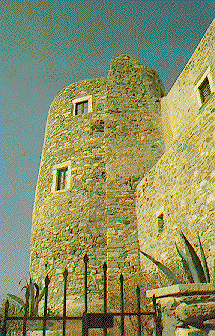 The capital of the island, Hora, is built in the west side and is one of the most beautiful
towns of the Cyclades with monuments of different eras. In the entrance of the harbour, on the
small island, there is a huge gate, the "Portara", the remain of the half-finished archaic
temple of Apollo (6th century B.C.), the palace of Ariadne according to the tradition.A church was
built there in the Byzantine period, but it was destroyed in 1344 from the turkish invasions and
never rebuilt.
The capital of the island, Hora, is built in the west side and is one of the most beautiful
towns of the Cyclades with monuments of different eras. In the entrance of the harbour, on the
small island, there is a huge gate, the "Portara", the remain of the half-finished archaic
temple of Apollo (6th century B.C.), the palace of Ariadne according to the tradition.A church was
built there in the Byzantine period, but it was destroyed in 1344 from the turkish invasions and
never rebuilt.Hora with its ascenting streets and old houses (3 floors sometimes) is dominated by the volume of the Venetian castle.The Catholic residents of Hora used to live in the castle, which was built by Marco Sanudo in 1207, while the Orthodox lived in Bourgos.There was also a third neighbourhood, a Jewish.From the Venetian castle some parts of the surounding wall, three gates and seven towers are still preserved. Inside there are the monasteries of the Ursuline, the Kaputsino and the old Commercial School, where the Archaeological Museum is situated.In the museum one can see significant findings of the primary phases of the Cycladic civilization and also sculptures and Kouroi.The Byzantine and Folklore Museum is sheltered in a restored tower. In the center of the castle lies the Catholic Cathedral with Fraggic possesions at the entrance.There is also the ruined palace of Sanudo near there.
In Hora, apart from the old wealthy houses, many significant Byzantine and Metabyzantine churches
are preserved : Cathedral (18th century), Panagia Hrisopolitissa (one of the oldest of the island),
Profitis Ilias (with two valuable pictures of the painter of the 16th century Angel).In Grotta
there is Agios Georgios (1200 approximately) and near Palatia Agios Antonios of the Catholics (15th
century.In Grotta, as well as in Aplomata, the excavations brought to light the settlements of a
primary Cycladic civilization with rich findings (in Aplomata the inhabitance was continuous until
the Geometric period
 -8th century- while there are findings of 4th century B.C. as well) and along
with the findings in other areas prove that Naxos was one of the centers of the Cycladic civilization.
3 km outside Hora lies the monastery of Agios Ioannis o Hrisostomos.
-8th century- while there are findings of 4th century B.C. as well) and along
with the findings in other areas prove that Naxos was one of the centers of the Cycladic civilization.
3 km outside Hora lies the monastery of Agios Ioannis o Hrisostomos.
From Hora one can visit all the villages of the island from the nearest to the most remote and enjoy the beautiful nature, the Venetian towers and the churches. In Aggidia (2 km outside Hora) there are the remains of an ancient temple and the twin (Catholic and Orthodox) church of Agios Artemios. In Galanado the Venetian tower of Belogna, which was in a time the summer resort of the Catholic bishop,is still preserved.Moving down to the south we find the monastery of the Timios Stavros, also known as The Bazaios tower.
The prettiest and one of the most fertile areas of the island is that of Tragea,called by this
name from the ancient years, full of crops with beautiful houses, churches and towers. In Halki
(Halkeio) there are the churches of Panagia Protorthroni(10th/12th century), Agios Georgios
Diasoritis (11th century) with great wall paintings and in the east the Venetia tower of Barozzi,
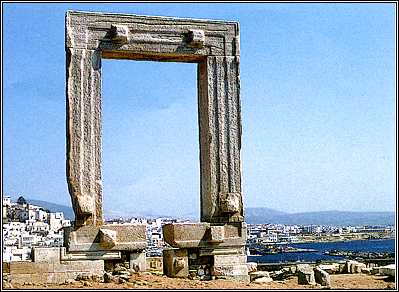 residence of the feudal family of the region, property of the Gratsia family. Other things to mention
are the churches of Panagia Damniotissa in Kaloxilo and Agios Nikolaos in Akadimi, where the tower
of Makropoliti is situated. In Moni (4 km N.E. of Halki) there is the Byzzantine church of
Panagia Drosiani (6th century), the oldest of the island. Norther of Halki, the churches of
Agios Isidoros, Panagia Rahidiotissa as well as the ruins of the Catholic monastery of Agios
Fragkiskos are preserved. Wester of Halki one can see the ruins of the Venetian Apano Kastro
(1250 approximately). In Potamia there are the ruins of Venetian towers and the Byzantine church
of Agios Mamas (9th century).
residence of the feudal family of the region, property of the Gratsia family. Other things to mention
are the churches of Panagia Damniotissa in Kaloxilo and Agios Nikolaos in Akadimi, where the tower
of Makropoliti is situated. In Moni (4 km N.E. of Halki) there is the Byzzantine church of
Panagia Drosiani (6th century), the oldest of the island. Norther of Halki, the churches of
Agios Isidoros, Panagia Rahidiotissa as well as the ruins of the Catholic monastery of Agios
Fragkiskos are preserved. Wester of Halki one can see the ruins of the Venetian Apano Kastro
(1250 approximately). In Potamia there are the ruins of Venetian towers and the Byzantine church
of Agios Mamas (9th century).
From Halki the road takes us to Filoti with the church of Panagia (Kimisi) and the tower of Barozzi. In the S.E. of the village up in the mountain of Zas there is the worshiping cave of Zas or Vakhides, where according to the tradition Zeus was born.East to Filoti, 7 km, there is the village Danakos and 4,5 km N.E. the beautiful village of Apeiranthos with the intense Venetian characteristic in the architecture of the houses and the towers of Sommaripa, Crispi and Sfortza-Kastri. The village distinquishes for its customs and the rich folk tradition. In the local museum an important collection of findings from of the primary years of the Cycladic civilization is sheltered. Among the findings one can find a series of stones in which scenes from everyday life are curved (dance, hunting, animals, boats) or linear sketches.A little farther from the village there are the churches of Theologos (14th century), Agia Kiriaki (9th century) and Theotokos (13th century).
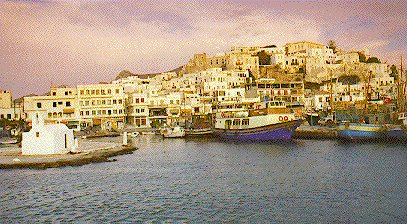 In the S.W. of Hora there are also beautiful villages with windmills and other sights.
In Glinado the churches of Agios Georgios and Agii Saranda are quite noteworthy.In the west of
Tripodes lies Agios Matthaios and the ruins of Plaka's Paliopirgos.Souther,near the coast, there
is Polihni where signs of prehistoric settlement were found as well as the remains of a Venetian tower.
In Sagri the towers of Sommaripa, Della Rokka, Palaiologos and Barozzi, the Byzantine churches of Agii Anargiri,
Agios Ioannis in the place of the ancient temple of Dimetra and Persefone, Agios Eleftherios,
Panagia Kaloritissa in the east, Agios Nikolaos (10th/13th century) in the south, Panagia
Arkouliotissa and Agii Akindinoi and Georgios are worthy of mentioning. At the south of Sagri lies
the ruined medieval castle of Apaliros. In the S.E. the imposing tower of Himaros,which one can
reach from Filoti, raises.
In the S.W. of Hora there are also beautiful villages with windmills and other sights.
In Glinado the churches of Agios Georgios and Agii Saranda are quite noteworthy.In the west of
Tripodes lies Agios Matthaios and the ruins of Plaka's Paliopirgos.Souther,near the coast, there
is Polihni where signs of prehistoric settlement were found as well as the remains of a Venetian tower.
In Sagri the towers of Sommaripa, Della Rokka, Palaiologos and Barozzi, the Byzantine churches of Agii Anargiri,
Agios Ioannis in the place of the ancient temple of Dimetra and Persefone, Agios Eleftherios,
Panagia Kaloritissa in the east, Agios Nikolaos (10th/13th century) in the south, Panagia
Arkouliotissa and Agii Akindinoi and Georgios are worthy of mentioning. At the south of Sagri lies
the ruined medieval castle of Apaliros. In the S.E. the imposing tower of Himaros,which one can
reach from Filoti, raises.
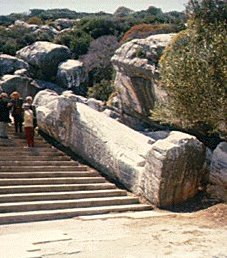 In the S.E. coast, in the bay of Panormos, in the position called "Korfari ton Amigdalion", the
remains of a protected prehistoric settlement (2400-2300 B.C.) were found.
In the S.E. coast, in the bay of Panormos, in the position called "Korfari ton Amigdalion", the
remains of a protected prehistoric settlement (2400-2300 B.C.) were found.
In the east side and from Hora to Eggares near the village Galini lies the monastery of Ipsili, protected by a tower built in 1600 by Jacob Kokkos.A Venetian tower is also preserved in the southern of Kourounohori, from where the road leads to Kinidaros, where there was a temple of Artemis.Norther from the village, in Flerio, there is a half-finished archaic kouros (6th century).
In the N.E. side of the island, where one can reach from the rad that leads to Apeiranthos, there are the villages Koronos, Skado, Komiaki (Koronida) and Apollonas, where a colossal half-finished statue of a kouros representing Apollo (7th century) lies in the place that it was first found. Souther in the position "Kalogeros" ruins of a medieval fortress are preserved.
Important Castles and Towers in Naxos :